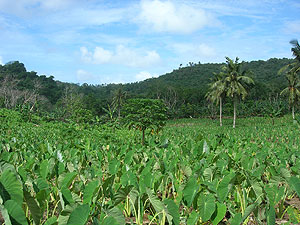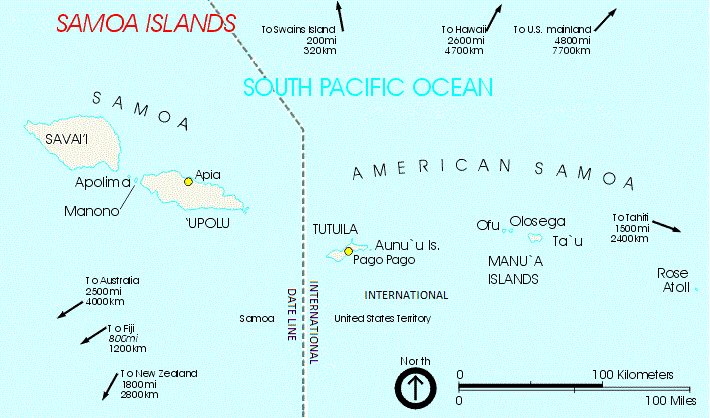|
Vaitogi, American Samoa
Vaitogi is a village in American Samoa. It has many missionaries and tourists who are attracted by shopping for local products. Vaitogi might be most famous of its legends about the Turtle and Shark (Laumei ma Malie). It is said that once, at a time when food was scarce, an old woman took her granddaughter to the bluff at Vaitogi, and holding hands, they leaped into the sea down below. While the young girl was transformed into a shark, the blind grandmother became a turtle. It gives its name to a local U-shaped cove in town, which was listed on the U.S. National Register of Historic Places in 2014. Fogāma'a Crater Trail is a 3-mile roundtrip hiking trail in Vaitogi. The trail goes by two scenic beaches before ending at the junction with the Fagatele Bay National Marine Sanctuary Trail. Fogāma'a Crater is a National Natural Landmark. It is home to Tessarea Vaitogi Inn, which is a hotel in town. Etymology Although there is no specific account of the name’s origin, the name m ... [...More Info...] [...Related Items...] OR: [Wikipedia] [Google] [Baidu] |
Samoan Language
Samoan ( or ; ) is a Polynesian language spoken by Samoans of the Samoan Islands. Administratively, the islands are split between the sovereign country of Samoa and the United States territory of American Samoa. It is an official language, alongside English, in both jurisdictions. It is widely spoken across the Pacific region, heavily so in New Zealand and also in Australia and the United States. Among the Polynesian languages, Samoan is the most widely spoken by number of native speakers. Samoan is spoken by approximately 260,000 people in the archipelago and with many Samoans living in diaspora in a number of countries, the total number of speakers worldwide was estimated at 510,000 in 2015. It is the third-most widely spoken language in New Zealand, where 2.2% of the population, 101,900 people, were able to speak it as of 2018. The language is notable for the phonological differences between formal and informal speech as well as a ceremonial form used in Samoan oratory ... [...More Info...] [...Related Items...] OR: [Wikipedia] [Google] [Baidu] |
1980 United States Census
The United States census of 1980, conducted by the Census Bureau, determined the resident population of the United States to be 226,545,805, an increase of 11.4 percent over the 203,184,772 persons enumerated during the 1970 census. It was the first census in which a stateCaliforniarecorded a population of 20 million people, as well as the first in which all states recorded populations of over 400,000. Census questions The 1980 census collected the following information from all respondents: * Address * Name * Household relationship * Gender * Race * Age * Marital status * Whether of Spanish/Hispanic origin or descent It was the first census not to ask for the name of the "head of household." Approximately 16 percent of households received a "long form" of the 1980 census, which contained over 100 questions. Full documentation on the 1980 census, including census forms and a procedural history, is available from the Integrated Public Use Microdata Series. Data availabi ... [...More Info...] [...Related Items...] OR: [Wikipedia] [Google] [Baidu] |
Fagatogo Market
Fagatogo Market is a market centred in the Fagatogo area of Pago Pago, the capital of American Samoa. It opened in 2010 for farmers and fishermen to sell fruits, vegetables and fish. Souvenirs are sold among live entertainment here when cruise ships are in town. It lies in front of Pago Pago's main bus terminal. Nearby are Fagatogo Square Shopping Mall. Mount 'Alava, the canneries in Atu'u, Rainmaker Mountain and Pago Pago Harbor Pago Pago Harbor on Tutuila Island in American Samoa is one of the world's largest natural harbors. The capital, Pago Pago is located on the inner reaches of the harbor, close to its northwesternmost point. It has the highest annual rainfall of ....Stanley, David (2004). ''Moon Handbooks South Pacific''. Page 470. . References {{reflist Pago Pago 2010 establishments in American Samoa ... [...More Info...] [...Related Items...] OR: [Wikipedia] [Google] [Baidu] |
Architecture Of Samoa
The architecture of Samoa is characterised by openness, with the design mirroring the culture and life of the Samoan people who inhabit the Samoa Islands. Recording the Cultural Heritages of Samoa and the Fiji Islands, U. Herbig, G. Zohrer, F. Samoliy. Retrieved 26 October 2009 Architectural concepts are incorporated into Samoan proverbs, oratory and metaphors, as well as linking to other art forms in Samoa, such as boat building and [...More Info...] [...Related Items...] OR: [Wikipedia] [Google] [Baidu] |
National Marine Sanctuary
A U.S. National Marine Sanctuary is a zone within United States waters where the marine environment enjoys special protection. The program began in 1972 in response to public concern about the plight of marine ecosystems. A U.S. National Marine Sanctuary is a federally designated area within United States waters that protects areas of the marine environment with special conservation, recreational, ecological, historical, cultural, archeological, scientific, educational, or aesthetic qualities. While National Marine Sanctuaries are multiple-use areas, the NMSA emphasizes that one of the express purposes of a sanctuary is to “maintain the natural biological communities” and to “protect and, where appropriate, restore and enhance natural habitats, populations, and ecological processes.” The National Marine Sanctuary System consists of 15 marine protected areas that encompass more than . Individual areas range from less than . The Office of National Marine Sanctuaries (ONMS) ... [...More Info...] [...Related Items...] OR: [Wikipedia] [Google] [Baidu] |
Tutuila Island
Tutuila is the main island of American Samoa (and its largest), and is part of the archipelago of Samoan Islands. It is the third largest island in the Samoan Islands chain of the Central Pacific. It is located roughly northeast of Brisbane, Australia and lies over to the northeast of Fiji. It contains a large, natural harbor, Pago Pago Harbor, where Pago Pago, the capital of American Samoa, is situated. Pago Pago International Airport is also located on Tutuila. The island’s land expanse is about 68% of the total land area of American Samoa. With 56,000 inhabitants, it is also home to 95% of the population of American Samoa. The island has six terrestrial and three marine ecosystems. Tutuila has mountainous regions, the highest point of which is ). The island is attractive to tourists because of its beaches, coral reefs, and World War II relics, as well as its suitability for sporting activities such as scuba diving, snorkeling, and hiking. Etymology It is said that the ... [...More Info...] [...Related Items...] OR: [Wikipedia] [Google] [Baidu] |
Pago Pago
Pago Pago ( ; Samoan: )Harris, Ann G. and Esther Tuttle (2004). ''Geology of National Parks''. Kendall Hunt. Page 604. . is the territorial capital of American Samoa. It is in Maoputasi County on Tutuila, which is American Samoa's main island. Pago Pago is home to one of the deepest natural deepwater harbors in the South Pacific Ocean, sheltered from wind and rough seas, and strategically located.United States Central Intelligence Agency (2016). ''The World Factbook 2016–17''. Government Printing Office. Page 19. .Grabowski, John F. (1992). ''U.S. Territories and Possessions (State Report Series)''. Chelsea House Pub. .Kristen, Katherine (1999). ''Pacific Islands (Portrait of America)''. San Val. . The harbor is also one of the best protected in the South Pacific,Leonard, Barry (2009). ''Minimum Wage in American Samoa 2007: Economic Report''. Diane Publishing. . which gives American Samoa a natural advantage because it makes landing fish for processing easier. Tourism, ent ... [...More Info...] [...Related Items...] OR: [Wikipedia] [Google] [Baidu] |
Margaret Mead
Margaret Mead (December 16, 1901 – November 15, 1978) was an American cultural anthropologist who featured frequently as an author and speaker in the mass media during the 1960s and the 1970s. She earned her bachelor's degree at Barnard College of Columbia University and her M.A. and Ph.D. degrees from Columbia. Mead served as president of the American Association for the Advancement of Science in 1975. Mead was a communicator of anthropology in modern American and Western culture and was often controversial as an academic. Her reports detailing the attitudes towards sex in South Pacific and Southeast Asian traditional cultures influenced the 1960s sexual revolution. She was a proponent of broadening sexual conventions within the context of Western cultural traditions. Birth, early family life, and education Margaret Mead, the first of five children, was born in Philadelphia but raised in nearby Doylestown, Pennsylvania. Her father, Edward Sherwood Mead, was a professor ... [...More Info...] [...Related Items...] OR: [Wikipedia] [Google] [Baidu] |
1930 United States Census
The United States census of 1930, conducted by the Census Bureau one month from April 1, 1930, determined the resident population of the United States to be 122,775,046, an increase of 13.7 percent over the 106,021,537 persons enumerated during the 1920 census. Census questions The 1930 census collected the following information: * address * name * relationship to head of family * home owned or rented ** if owned, value of home ** if rented, monthly rent * whether owned a radio set * whether on a farm * sex * race * age * marital status and, if married, age at first marriage * school attendance * literacy * birthplace of person, and their parents * if foreign born: ** language spoken at home before coming to the U. S. ** year of immigration ** whether naturalized ** ability to speak English * occupation, industry and class of worker * whether at work previous day (or last regular work day) * veteran status * if Indian: ** whether of full or mixed blood ** tribal affiliation ... [...More Info...] [...Related Items...] OR: [Wikipedia] [Google] [Baidu] |
1940 United States Census
The United States census of 1940, conducted by the Census Bureau, determined the resident population of the United States to be 132,164,569, an increase of 7.3 percent over the 1930 population of 122,775,046 people. The census date of record was April 1, 1940. A number of new questions were asked including where people were five years before, highest educational grade achieved, and information about wages. This census introduced sampling techniques; one in 20 people were asked additional questions on the census form. Other innovations included a field test of the census in 1939. This was the first census in which every state (48) had a population greater than 100,000. Census questions The 1940 census collected the following information: * address * home owned or rented ** if owned, value ** if rented, monthly rent * whether on a farm * name * relationship to head of household * sex * race * age * marital status * school attendance * educational attainment * birthplace * if f ... [...More Info...] [...Related Items...] OR: [Wikipedia] [Google] [Baidu] |







.jpg)
